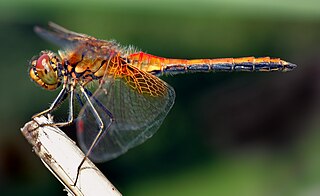
A dragonfly is a flying insect belonging to the order Odonata, infraorder Anisoptera. About 3,000 extant species of true dragonfly are known. Most are tropical, with fewer species in temperate regions. Loss of wetland habitat threatens dragonfly populations around the world. Adult dragonflies are characterized by a pair of large, multifaceted compound eyes, two pairs of strong, transparent wings, sometimes with coloured patches, and an elongated body. Many dragonflies have brilliant iridescent or metallic colours produced by structural colouration, making them conspicuous in flight. An adult dragonfly's compound eyes have nearly 24,000 ommatidia each.

Aeshna isoceles is a small hawker dragonfly that is found in Europe, mostly around the Mediterranean, and the lowlands of North Africa. Its common name in English is green-eyed hawker. In Britain it is a rare and local species and is known as the Norfolk hawker. It has a brown colour with green eyes and clear wings and also a yellow triangular mark on the second abdominal segment which gave rise to its scientific name. It used to be in the genus Anaciaeschna as it has several differences from the other members of the genus Aeshna. Its specific name is often spelt isosceles.
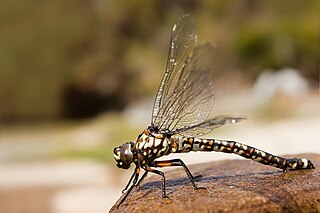
The Aeshnidae, also called aeshnids, hawkers, or darners, is a family of dragonflies. The family includes the largest dragonflies found in North America and Europe and among the largest dragonflies on the planet.
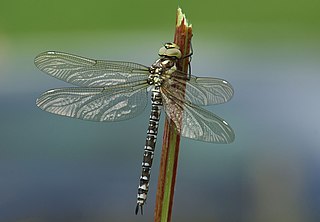
Aeshna, or the mosaic darners, is a genus of dragonflies from the family Aeshnidae. Species within this genus are generally known as "hawkers" or "darners".

The migrant hawker is one of the smaller species of hawker dragonflies. It can be found away from water but for breeding it prefers still or slow-flowing water and can tolerate brackish sites. The flight period is from July to the end of October. A. mixta occurs in North Africa, southern and central Europe to the Baltic region.
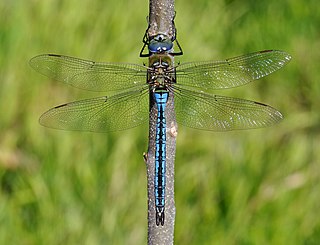
The emperor dragonfly or blue emperor is a large species of hawker dragonfly of the family Aeshnidae, averaging 78 millimetres (3.1 in) in length. The generic name Anax is from the ancient Greek ἄναξ, "lord"; the specific epithet imperator is the Latin for "emperor", from imperare, to command.

The common darter is a dragonfly of the family Libellulidae native to Eurasia. It is one of the most common dragonflies in Europe, occurring in a wide variety of water bodies, though with a preference for breeding in still water such as ponds and lakes. In the south of its range adults are on the wing all year round.

The green darner or common green darner, after its resemblance to a darning needle, is a species of dragonfly in the family Aeshnidae. One of the most common and abundant species throughout North America, it also ranges south to Panama. It is well known for its great migration distance from the northern United States south into Texas and Mexico. It also occurs in the Caribbean, Tahiti, and Asia from Japan to mainland China. It is the official insect for the state of Washington in the United States.

The southern hawker or blue hawker is a species of hawker dragonfly.

The common hawker, moorland hawker or sedge darner is one of the larger species of hawker dragonflies. It is native to Palearctic and northern North America. The flight period is from June to early October.

The ruddy darter is a species of dragonfly of the family Libellulidae.
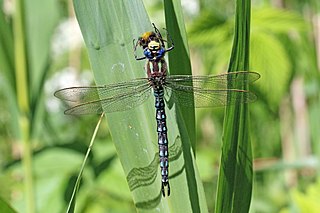
Brachytron is a monotypic genus of European dragonfly of the family Aeshnidae containing the hairy dragonfly, also known as the hairy hawker or spring hawker.
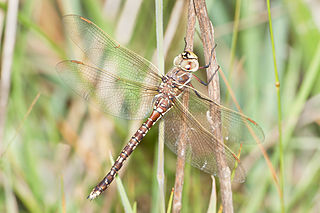
The blue-spotted hawker is the only known species of dragonfly of the genus Adversaeschna in the family Aeshnidae.

Aeshna affinis, the southern migrant hawker or blue-eyed hawker, is a dragonfly found in southern Europe and Asia. It is in the family Aeshnidae and is very similar in appearance to A. mixta.

The shadow darner is a species of dragonfly in the family Aeshnidae. It is found in almost all of Canada and most states in the United States.

The desert whitetail is a species of dragonfly in the family Libellulidae. P. subornata is often put into the genus Libellula.

Anax parthenope, the lesser emperor, is a dragonfly of the family Aeshnidae. It is found in Southern Europe, North Africa, Middle East and Asia.

Aeshna canadensis, the Canada darner, is a species of dragonfly in the family Aeshnidae. It is common throughout southern Canada and the northern United States.

Palaemnema domina, the desert shadowdamsel, is a species of damselfly in the family Platystictidae. It is native to the extreme south of the United States, Mexico and Central America.




















